Chapter 6 active transport and vesicular transport
1/35
There's no tags or description
Looks like no tags are added yet.
Name | Mastery | Learn | Test | Matching | Spaced |
|---|
No study sessions yet.
36 Terms
What does primary direct transport do (include enzyme used)? why does it do that?
ATPase hydrolyzes ATP to harvest energy to move molecules against their concentration gradient (low → high)
Against concentration gradient means
low → high
Primary direct is a type of ____ transport? Explain
Active bc uses ATP
“pump” always indicates
primary active transport
K+ is always be ___ concentration in the ECF and NA+ will always be ___ concentration in the ICF
Low
Ions like Cl- and Ca2+ are always are always [high] in the ___ because only K+ is [high] in the ____
(ICF/ECF)
ECF, ICF
Purpose of primary direct active transport? Why is this important?
Purpose is to maintain concentration gradient. The conc gradient is important because it is needed for secondary indirect active transport
PUMPKIN
(how many Na+ and now many K+ + what direction are they moving?)
3 Na out of cell
2 K into cell
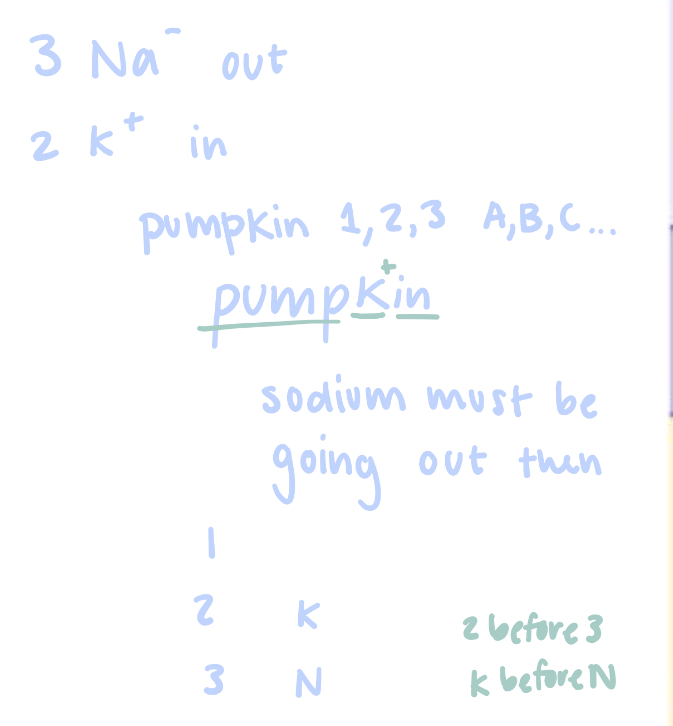
Na+/K+ pump is always initiated by ___, so the ATPase/carrier protein will grab ___ (# and ion) from the ___
Na+
3 Na+
ICF
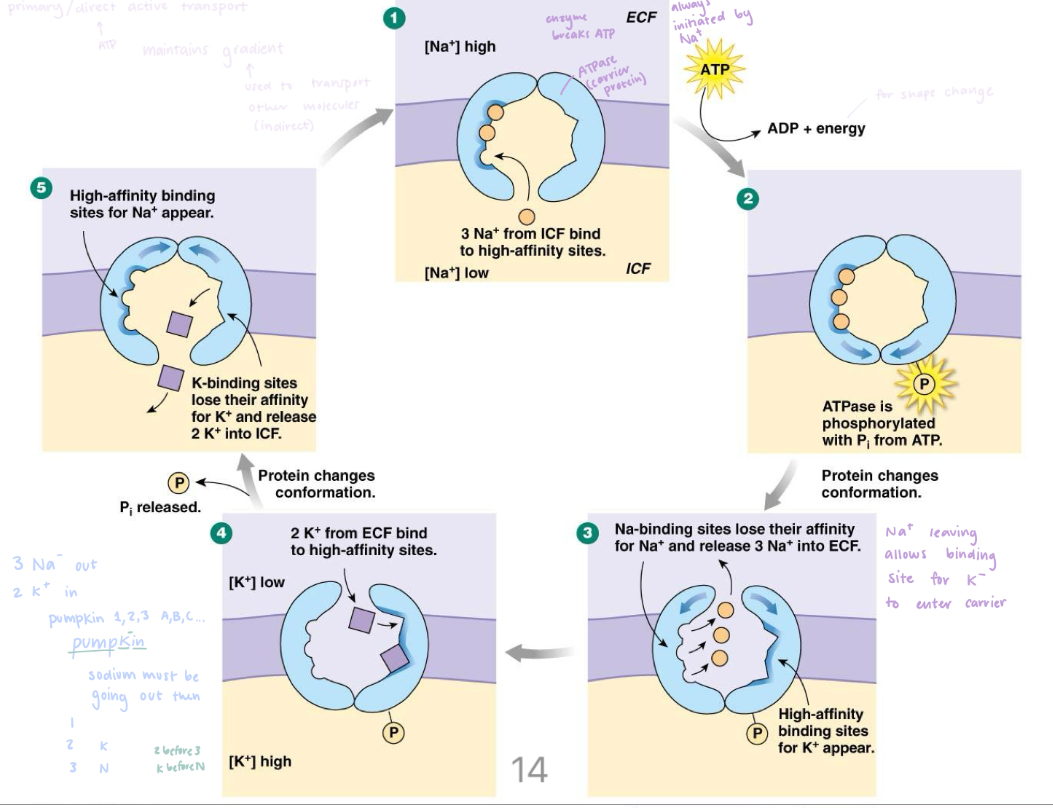
To move the 3 Na+ ions ____ is used to change the shape of the carrier protein
ATP energy
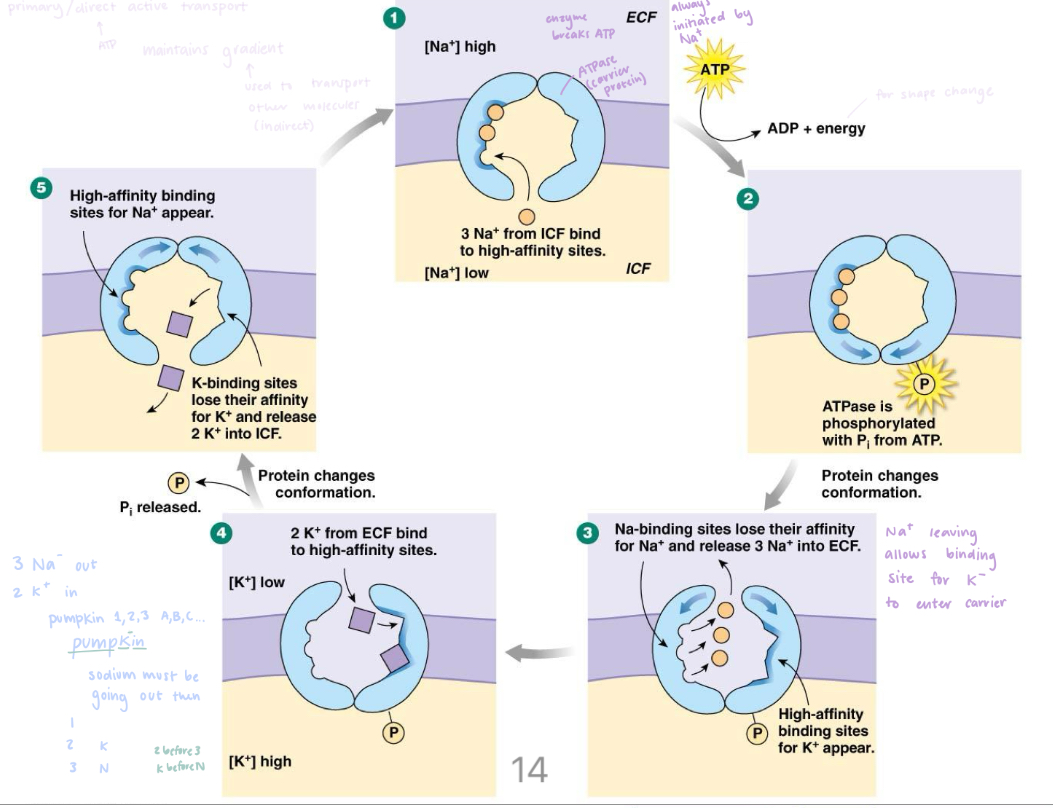
Na+ exits the cell allows for ____
The carrier protein to have the affinity to bind to K+
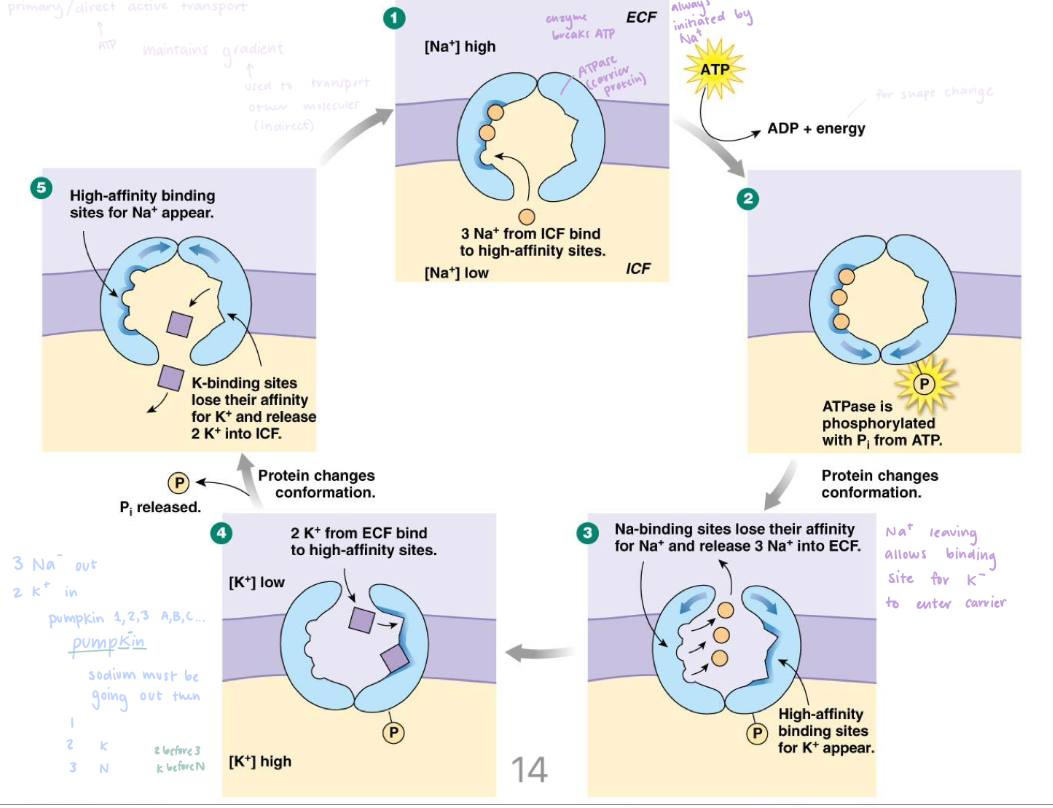
After Na+ leaves the carrier protein ___ (# and ion) from the ___ (ECF/ICF) binds to the carrier protein
2 K+
ECF
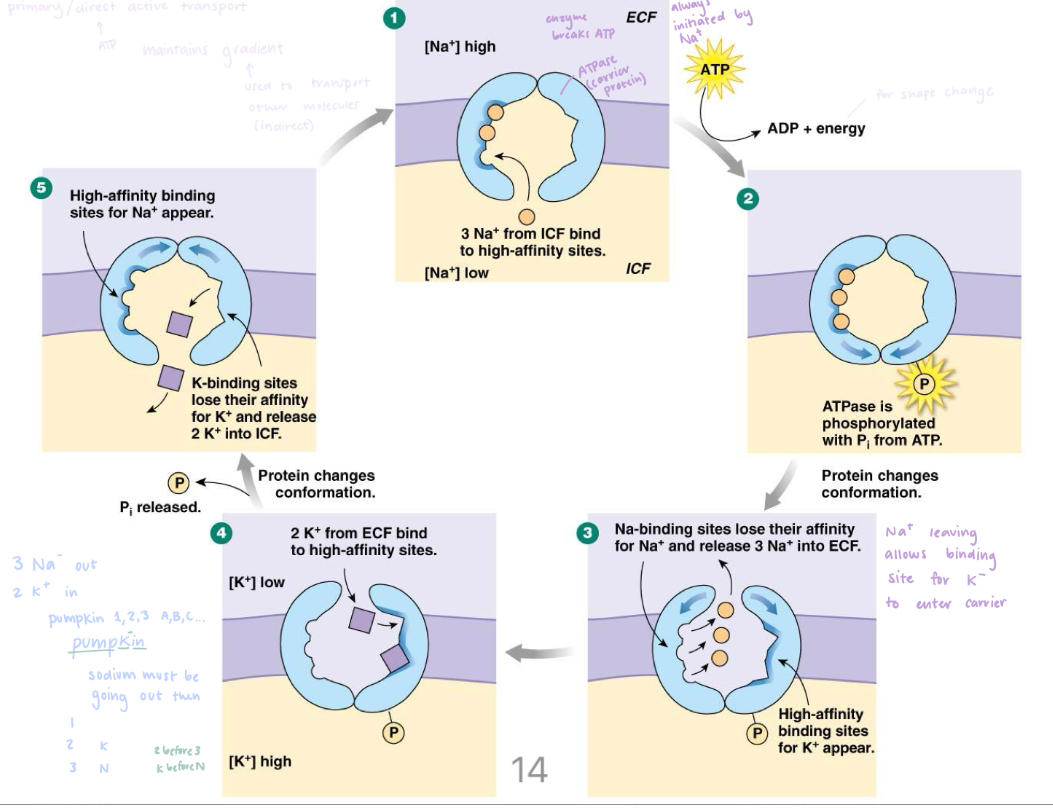
After K+ binds to carrier protein, the protein will ___ and release the 2 K+ into the ___ (ECF/ICF)
Change conformation (shapes)
ICF
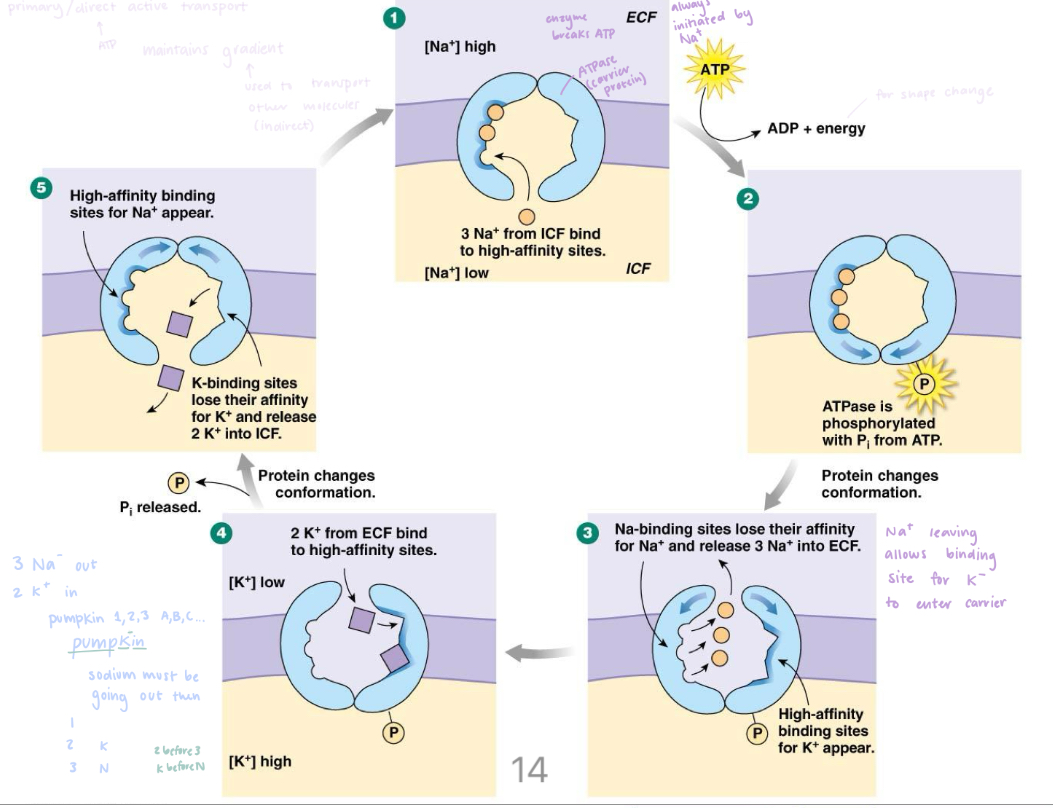
Steps for Na+/K+ pump
Always initiated by Na+, the ATPase/carrier protein will grab 3 Na+ ions from the ICF (against gradient)
To move the 3 Na+ ions ATP is used to change the shape of the carrier protein
3 Na+ exits the cell allows for the carrier protein to have the affinity to bind to K+
After Na+ leaves the carrier protein 2 K+ from the ECF binds to the carrier protein
After K+ binds to carrier protein, the protein will change conformation/shape and release the 2 K+ into the ICF
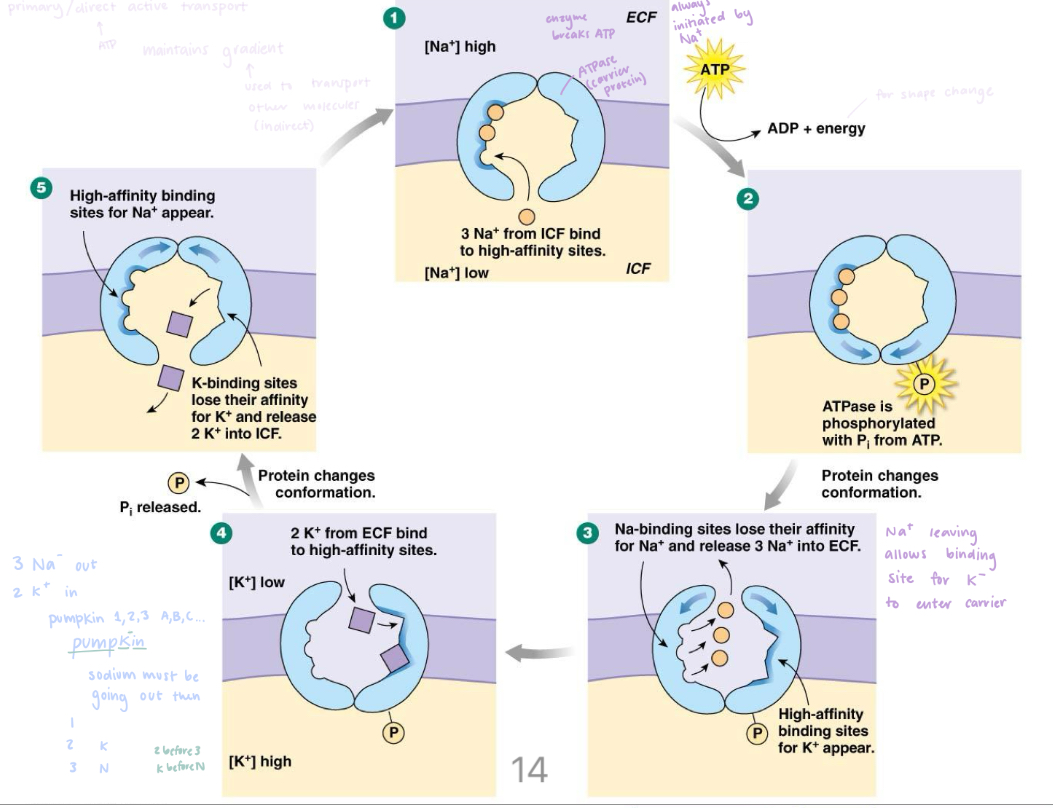
Secondary active transport is driven by ___ made by ____
concentration gradient
primary active transport
SGLT (name + how does it work + what type of transport + where it usually happens)
Na+ linked glucose transport
Na+ ions must be present too transport glucose through this carrier protein
indirect secondary transport
kidney and intestines
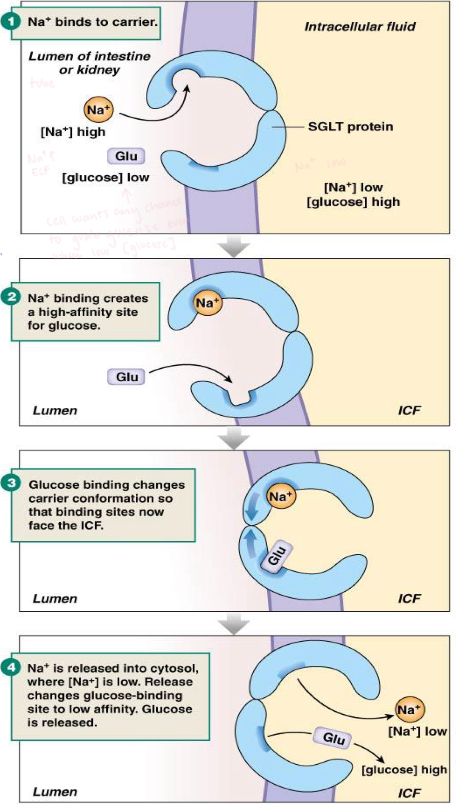
What is the purpose of SGLT?
cell ♡ glucose
To transport glucose from lumen of intestine or kidney to ICF even when the concentration of glucose is low in lumen
We have a natural Na+ concentration gradient so we use this to transport glucose against it’s conc gradient (indirect secondary transport)
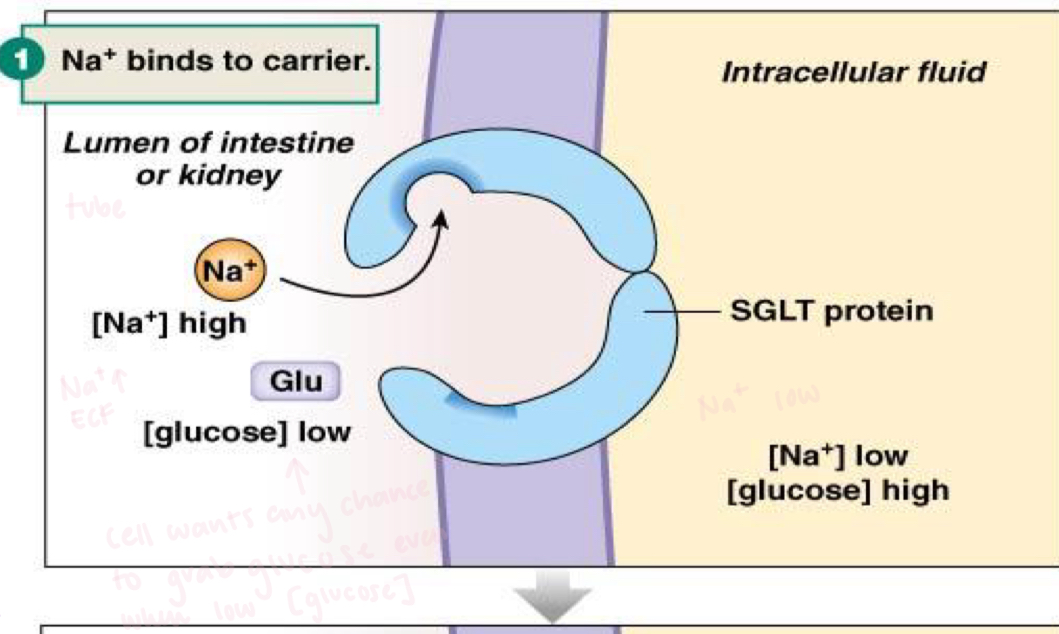
![<p>How primary direct transport and secondary indirect transport connect</p><ol><li><p>Primary active creates a concentration gradient by moving 3 Na<sup>+</sup> out the cell and 2 K<sup>+</sup> into of the cell using ATP to move against concentration gradient, low → high. This causes ___. </p></li><li><p>A) Due to low [Na+] in ICF, SGLT will want to bring more Na+ into cell using ____. </p></li></ol><p> B) This uses the made concentration gradient of Na+, made from ____, to bring Na+ into the cell ____ (does not use ATP). </p><ol start="3"><li><p>This means SGLT will cause ___ [Na+] inside the cell while the cell likes a ___ [Na+]. This in turn gives the Na<sup>+</sup>/K<sup>+</sup> pump ___ to pump out of the cell. It is a cycle to ____. </p></li><li><p>Since [K+] is high in cell due to Na<sup>+</sup>/K<sup>+</sup> pump, they will exit through the numerous ___ (unregulated) in the cell </p></li><li><p>K<sup>+</sup> leaky channel ___ [K<sup>+</sup>] in cell but the cell likes high [K<sup>+</sup>] so ___ (protein) will ___.</p></li></ol><p></p>](https://knowt-user-attachments.s3.amazonaws.com/3771135c-f355-4d52-ad4b-74ef78a40a1c.jpg)
How primary direct transport and secondary indirect transport connect
Primary active creates a concentration gradient by moving 3 Na+ out the cell and 2 K+ into of the cell using ATP to move against concentration gradient, low → high. This causes ___.
A) Due to low [Na+] in ICF, SGLT will want to bring more Na+ into cell using ____.
B) This uses the made concentration gradient of Na+, made from ____, to bring Na+ into the cell ____ (does not use ATP).
This means SGLT will cause ___ [Na+] inside the cell while the cell likes a ___ [Na+]. This in turn gives the Na+/K+ pump ___ to pump out of the cell. It is a cycle to ____.
Since [K+] is high in cell due to Na+/K+ pump, they will exit through the numerous ___ (unregulated) in the cell
K+ leaky channel ___ [K+] in cell but the cell likes high [K+] so ___ (protein) will ___.
This causes a low [K+] in ECF and a low [Na+] in ICF (written in purple)
A) secondary indirect active transport
B) primary active transport, using glucose (written in pink)
high, low, Na+, to maintain the concentration gradient (written in pink and purple)
K+ leaky channels (written in green)
lowers, Na+/K+ pump, pump the K+ right back in(written in green and purple)
![<ol><li><p>This causes a low [K+] in ECF and a low [Na+] in ICF (written in purple) </p></li><li><p>A) secondary indirect active transport</p></li></ol><p> B) primary active transport, using glucose (written in pink)</p><ol start="3"><li><p>high, low, Na<sup>+</sup>, to maintain the concentration gradient (written in pink and purple)</p></li><li><p> K+ leaky channels (written in green)</p></li><li><p>lowers, Na+/K+ pump, pump the K+ right back in(written in green and purple) </p></li></ol><p></p>](https://knowt-user-attachments.s3.amazonaws.com/049c6327-6a05-4280-ac10-8ec7bf1e28b5.jpg)
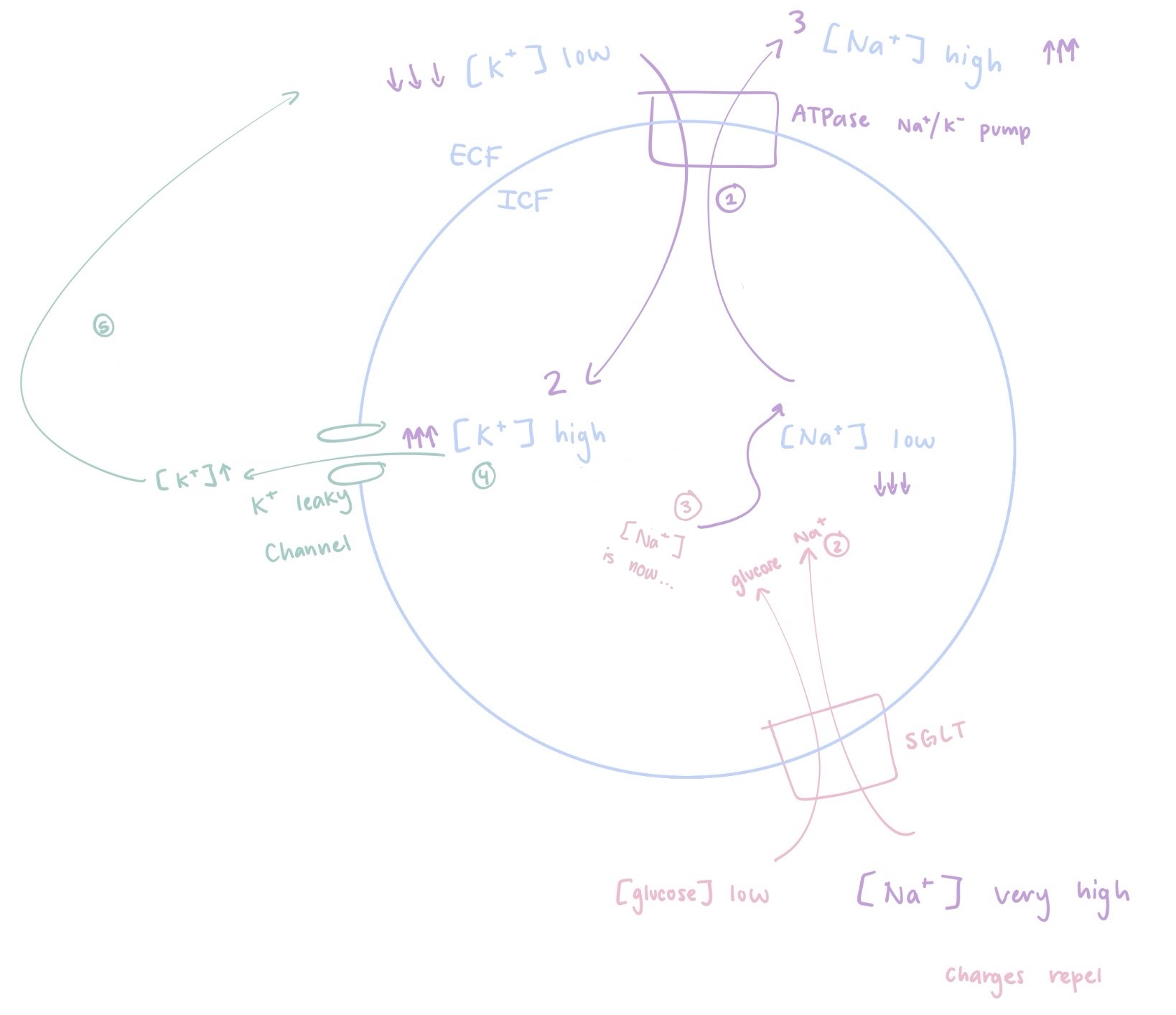
Explain how primary direct transport and secondary indirect transport connect
Primary active creates a concentration gradient by moving 3 Na+ out the cell and 2 K+ into of the cell using ATP to move against concentration gradient, low → high. This causes a low [K+] in ECF and a low [Na+] in ICF (written in purple)
Due to low [Na+] in ICF, SGLT will want to bring more Na+ into cell using secondary indirect active transport. This uses the made concentration gradient of Na+, made from primary active, to bring Na+ into using glucose (not ATP) (written in pink)
This means SGLT will cause high [Na+] inside the cell while the cell likes a low [Na+]. This in turn gives the Na+/K+ pump sodium to pump out of the cell. It is a cycle to maintain the concentration gradient (written in pink and purple)
Since [K+] is high in cell due to Na+/K+ pump, they will exit through the numerous K+ leaky channels (unregulated) in the cell (written in green)
K+ leaky channel lowers [K+] in cell but the cell likes high [K+] so Na+/K+ pump will pump the K+ right back in ((written in green and purple)
![<ol><li><p>Primary active creates a concentration gradient by moving 3 Na<sup>+</sup> out the cell and 2 K<sup>+</sup> into of the cell using ATP to move against concentration gradient, low → high. This causes a low [K+] in ECF and a low [Na+] in ICF (written in purple) </p></li><li><p>Due to low [Na+] in ICF, SGLT will want to bring more Na+ into cell using secondary indirect active transport. This uses the made concentration gradient of Na+, made from primary active, to bring Na+ into using glucose (not ATP) (written in pink)</p></li><li><p>This means SGLT will cause high [Na+] inside the cell while the cell likes a low [Na+]. This in turn gives the Na<sup>+</sup>/K<sup>+</sup> pump sodium to pump out of the cell. It is a cycle to maintain the concentration gradient (written in pink and purple) </p></li><li><p>Since [K+] is high in cell due to Na<sup>+</sup>/K<sup>+</sup> pump, they will exit through the numerous K<sup>+</sup> leaky channels (unregulated) in the cell (written in green)</p></li><li><p>K<sup>+</sup> leaky channel lowers [K<sup>+</sup>] in cell but the cell likes high [K<sup>+</sup>] so Na<sup>+</sup>/K<sup>+</sup> pump will pump the K<sup>+</sup> right back in ((written in green and purple) </p></li></ol><p></p>](https://knowt-user-attachments.s3.amazonaws.com/fb2f0df0-1c32-453f-b2d4-1797b1484ebe.jpg)
SGLT is mainly in the ___(organs) on ___ side of cell. Explain why it is on that side of the cell
Intestines and kidneys
on the apical side so that it can grab whatever Na+ and glucose that is in there from you eating
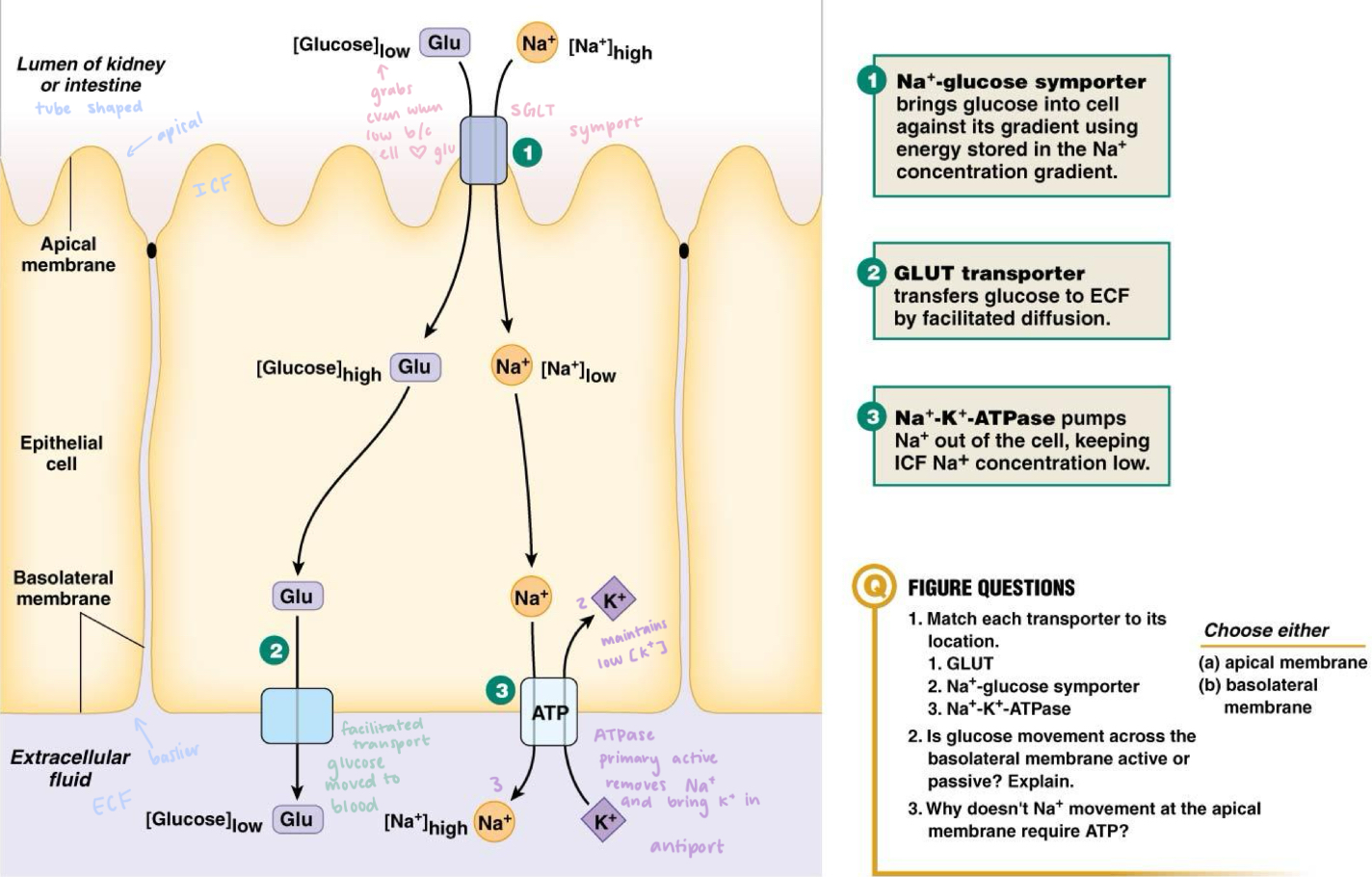
A GLUT transports glucose using ____ diffusion, and would be on the ___ side of the cell. Explain why it is on that side of the cell
Facilitated
Basal (basolateral) so that it can transport the glucose that SGLT brought into the cell to the ECF (blood) so it can go to liver
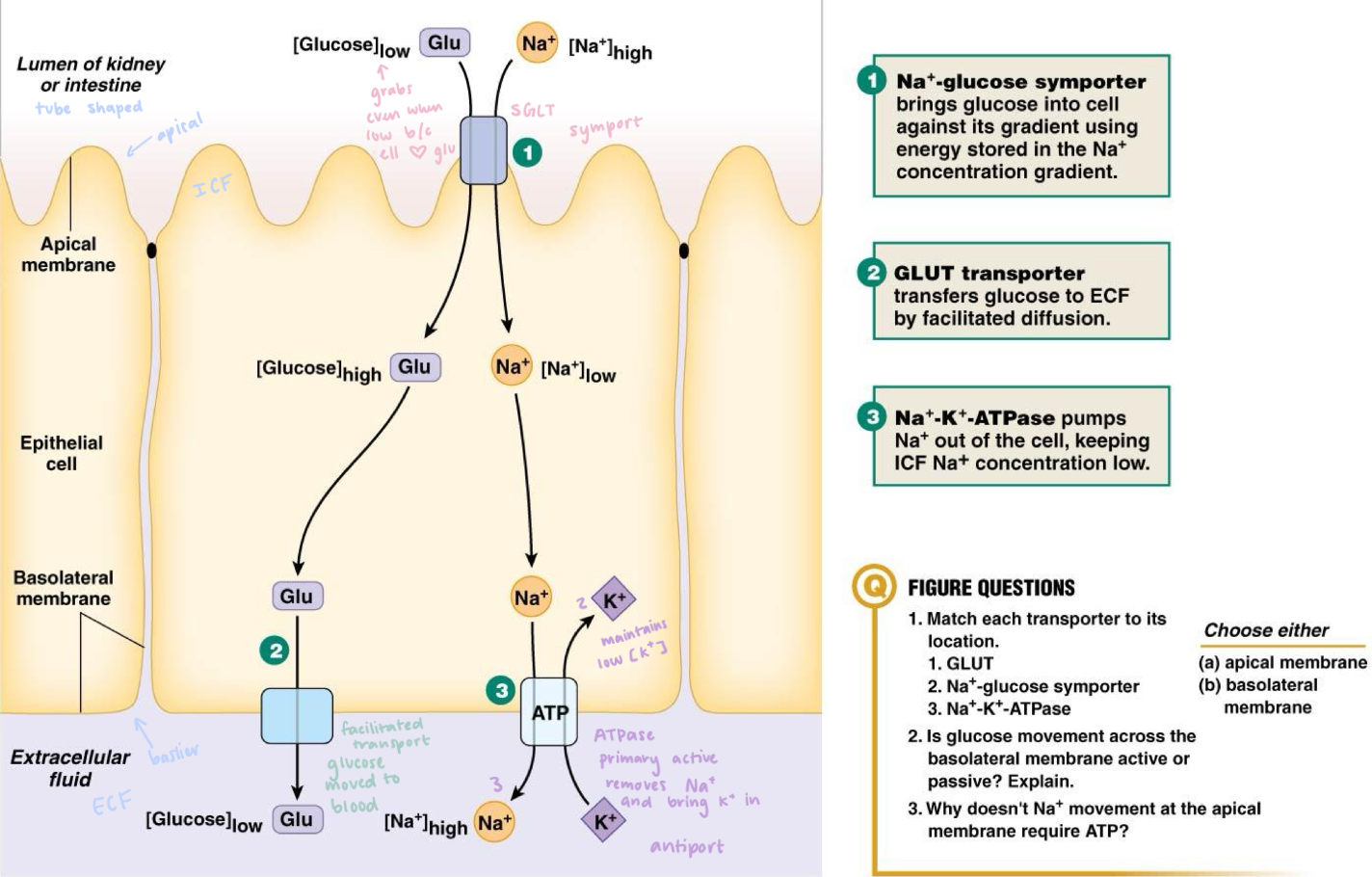
Na+/K+ pump is on the ___ side of the cell. Explain why it is on that side of the cell
Basal (basolateral) so that it can maintain the concentration gradient between the ECF and ICF/so that [Na+] inside the cell is not too high
![<p>Basal (basolateral) so that it can maintain the concentration gradient between the ECF and ICF/so that [Na<sup>+</sup>] inside the cell is not too high </p>](https://knowt-user-attachments.s3.amazonaws.com/96d8308a-a806-437b-a871-c01802a935ba.jpg)
SGLT is a ___
Na+/K+ pump is a ___
GULT is a ____
(uniport, symport, or antiport)
symport
antiport
uniport
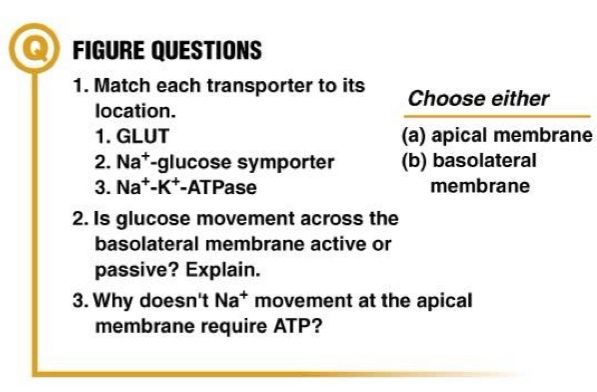
Questions 2 and 3
Passive because no ATP is used
Because SGLT it is secondary indirect transport and relies on the concentration gradient the Na+/K+ pump creates
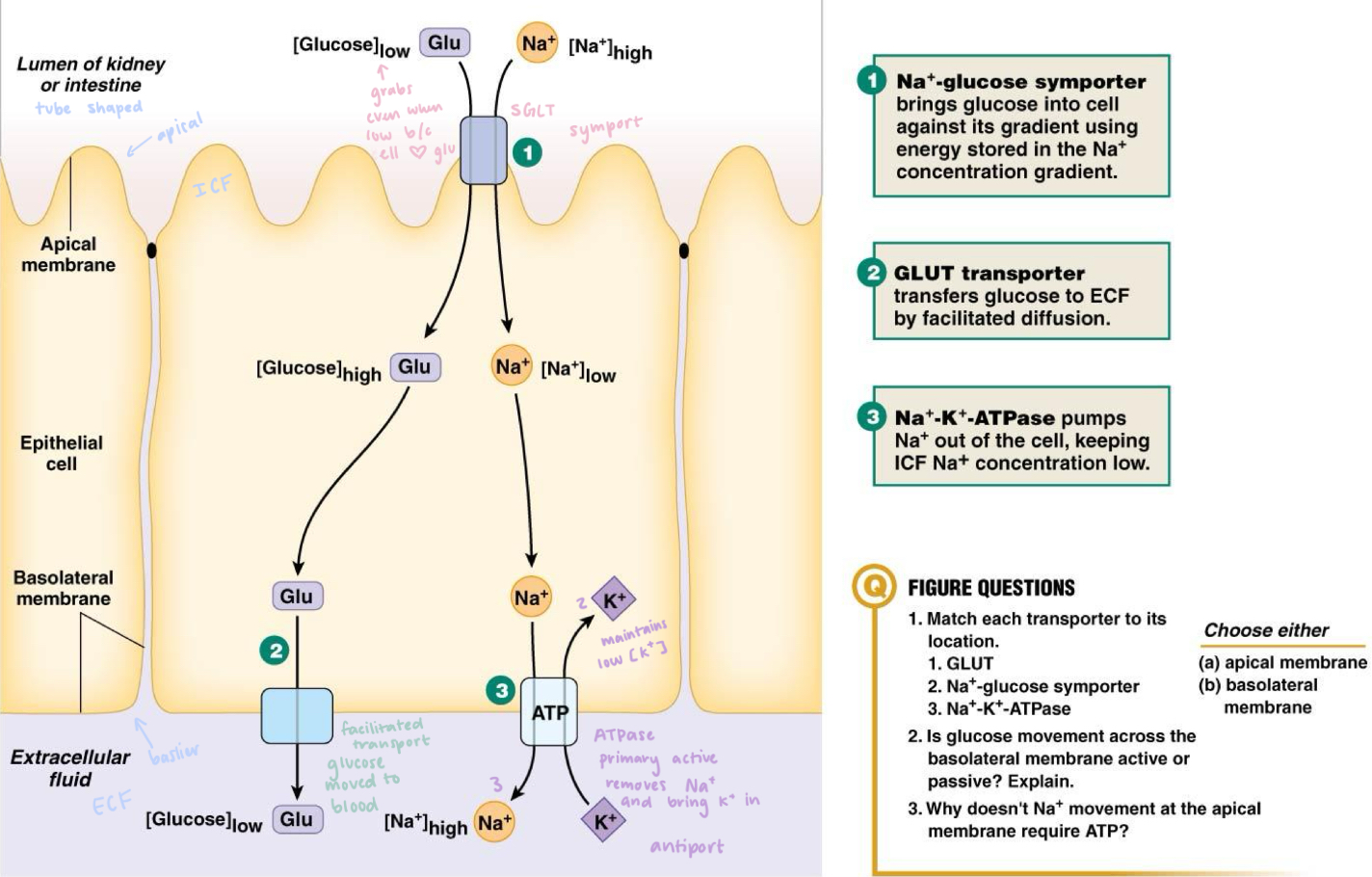
Vesicular transport is a type of ___ transport. Explain
Active transport because you need ATP to move larger molecules
Phagocytosis definition + how ti works
“Cell eating” where cell engulfs bacterium or large particles into a phagosome (large vesicle) using
Works by cell forming pseudo-arms around bacterium/large particle and bringing it entirely into cell to be contained in phagosome then killed by lysosomes digestive enzymes
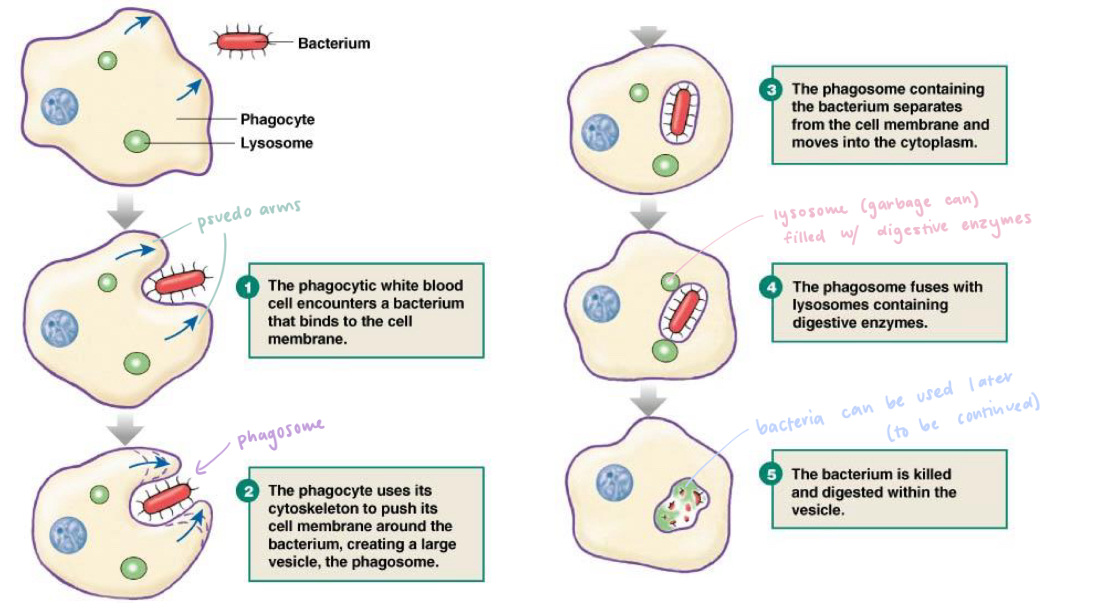
What are the 5 WBCs? Which ones can do phagocytosis?
Basophil, monocyte(blood)/macrophage(tissue), lymphocyte, neutrophil, eosinophils
Neutrophils and macrophage(tissue) can do phagocytosis
Endocytosis definition + types
Imports large, typically polar, molecules (solutes) from the ECF
pinocytosis or receptor-mediated
Pinocytosis definition + how it works
Type of endocytosis where we only want to take in ECF, so it takes a chunk of whatever is out there (not specific)
Pinches off a “chunk” of ECF

Receptor-mediated endocytosis
Type of endocytosis that is more specific because substrate binds to receptor
Difference between phagocytosis and endocytosis
Endocytosis is dealing bringing with solutes into celll and phagocytosis is dealing with bacterium/large particles into cell
Exocytosis definitions
Exports lipophobic (hydrophilic molecules out of cell
How would something like insulin be made and transported?
Exocytosis
Insulin needs to be made. Insulin is a protein so its starts by transcription in the nucleus → mRNA → cytoplasm → rough endoplasmic reticulum → ribosome that translate the protein → puts it in a transport vesicle → Golgi apparatus tp be corrected and folded correctly → another transport vesicle → EXOCYTOSIS sends insulin to the ECF
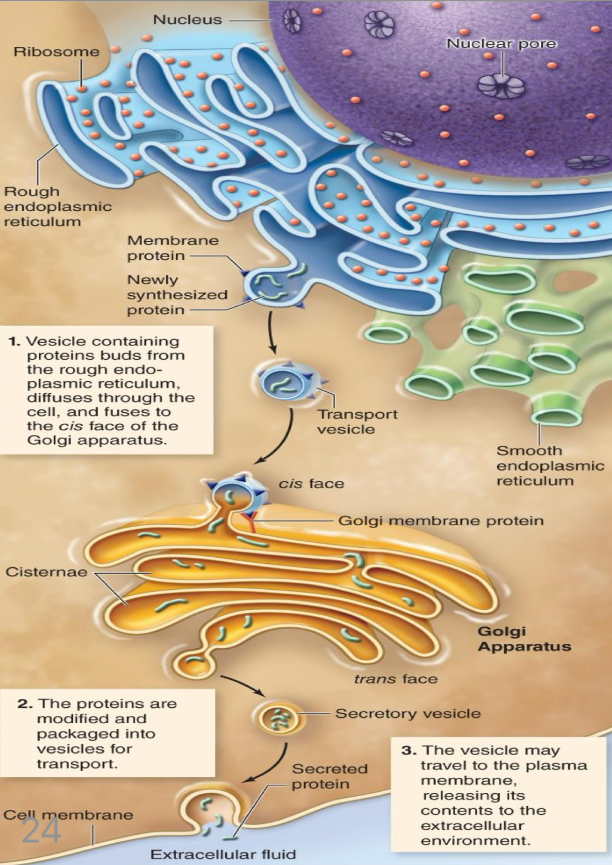
Membrane potential def + example
a voltage across a cell membrane created by difference in [ion], then diffusion of ions occurs when the cell is stimulated
EX: use of biceps vs use of triceps. the neurons of the triceps brachii will be stimulated when extending the forearms while the neurons of the biceps brachii will be at rest
![<ul><li><p>a voltage across a cell membrane created by difference in [ion], then diffusion of ions occurs when the cell is stimulated </p></li><li><p>EX: use of biceps vs use of triceps. the neurons of the triceps brachii will be stimulated when extending the forearms while the neurons of the biceps brachii will be at rest </p></li></ul><p></p>](https://knowt-user-attachments.s3.amazonaws.com/9835d073-35ba-4983-af25-51dc9fcfa31f.jpg)
Resting membrane potential def + example of how a cell can stay at rest + example of a cell at rest
In the absence of stimulation there is no charge in membrane potential bc ions are at an electro-chemical equilibrium
EX of how a cell can stay at res: the Na+/K+ pump compensating for the K+ leaky channels
EX of a cell at rest: when extending the forearm the neurons of the biceps brachii are at rest since we are using our triceps brachii to do so
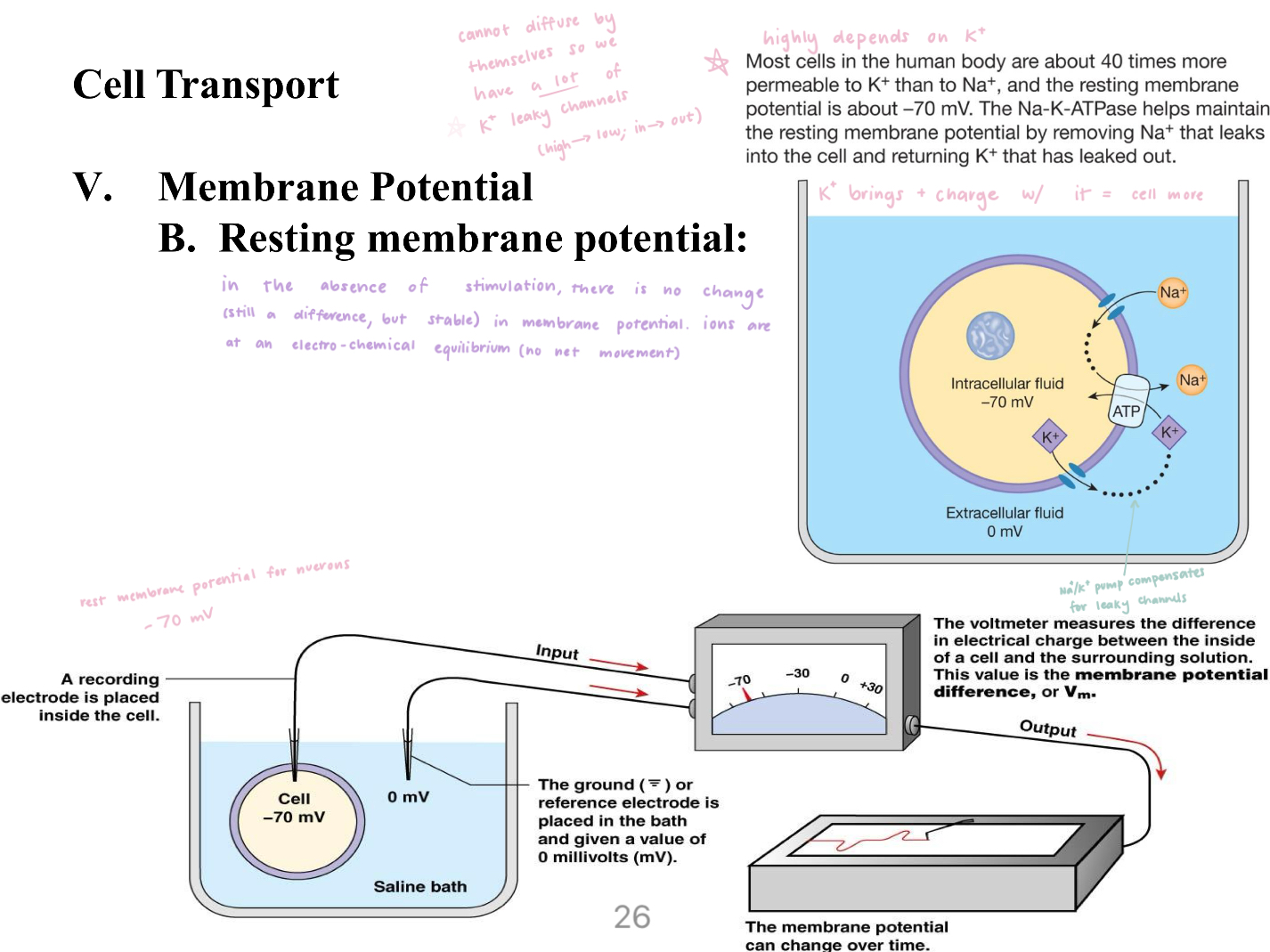
A resting cell is most permeable to ___
K+ bc the cell has a lot of K+ leaky channels